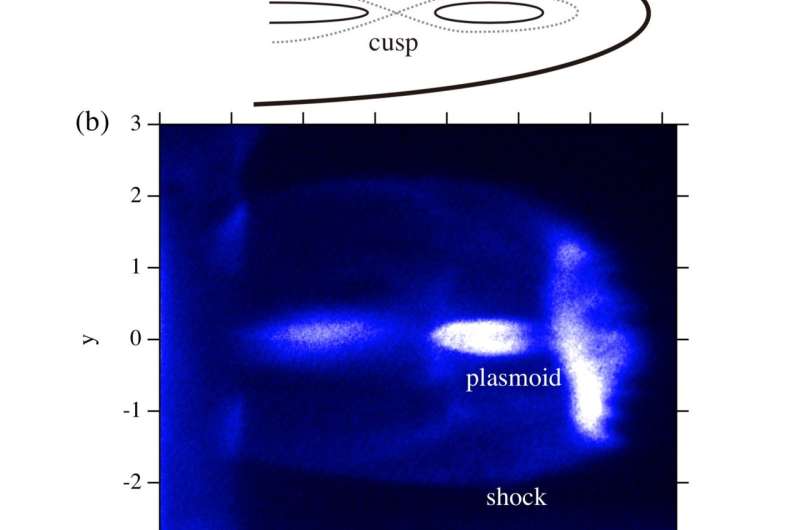Figure: Imaging of plasma emission shows the plasmoid and cusp-like features typical of magnetic reconnections. Credit: Osaka University
It has been difficult to simultaneously obtain micro- and macroscopic information in outer space. Global images of distant astrophysical phenomena provide macroscopic information, however local information is inaccessible. In contrast, in situ observations with spacecraft provide microscopic information of phenomena such as the Earth's magnetosphere, but it is difficult to obtain global information in near space.
In the so-called "laboratory astrophysics," a relatively new field born at Osaka University that has been adopted and developed all over the world, space and astrophysical phenomena are experimentally investigated.
A research group led by Yasuhiro Kuramitsu at Osaka University has revealed a magnetic reconnection driven by electron dynamics for the first time ever in laser-produced plasmas using the Gekko XII laser facility at the Institute of Laser Engineering, Osaka University. Magnetic reconnection is an essential factor in the universe, where the anti-parallel components of magnetic fields re-connect and release magnetic energy as plasma kinetic energy. Electron dynamics is considered to be essential in the triggering process of magnetic reconnection; however, it has been highly challenging to observe electron-scale, microscopic information together with the macroscopic reconnection structure in outer space.
The research group applied a weak magnetic field to the laser-produced plasma so that only electrons are directly coupled with the magnetic field. Plasma collimation was observed with interferometry only when the magnetic field was applied, i.e., the magnetic field was distorted by the plasma pressure and local anti-parallel. By further applying external pressure with an ambient plasma, a plasmoid associated with cusp-like features was observed through imaging of plasma emissions. The plasmoid propagated at the Alfvén velocity defined with electron mass, indicating the magnetic reconnection driven by electron dynamics.
The outcomes of this research will shed light on the role of electrons in laboratory plasmas. Since the spatio-temporal scales of electrons are much smaller than those of ions, it is highly challenging to resolve electron scale phenomena while imaging global structures of phenomena. This is also the case in outer space, as it has been difficult to obtain microscopic and macroscopic information simultaneously. In this study, the strength of the magnetic field is controlled to only allow electrons to couple with the magnetic field. This is a unique and powerful feature of laboratory experiment, and thus, laboratory astrophysics can be an alternative tool to investigate space and astrophysical phenomena. The roles of electron dynamics are essential not only to magnetic reconnection but also to various phenomena in the universe and in the laboratory, including fusion plasmas. Knowing more about the universe will lead to new technology in the future.
More information: Y. Kuramitsu et al. Magnetic reconnection driven by electron dynamics, Nature Communications (2018). DOI: 10.1038/s41467-018-07415-3
Journal information: Nature Communications
Provided by Osaka University
























